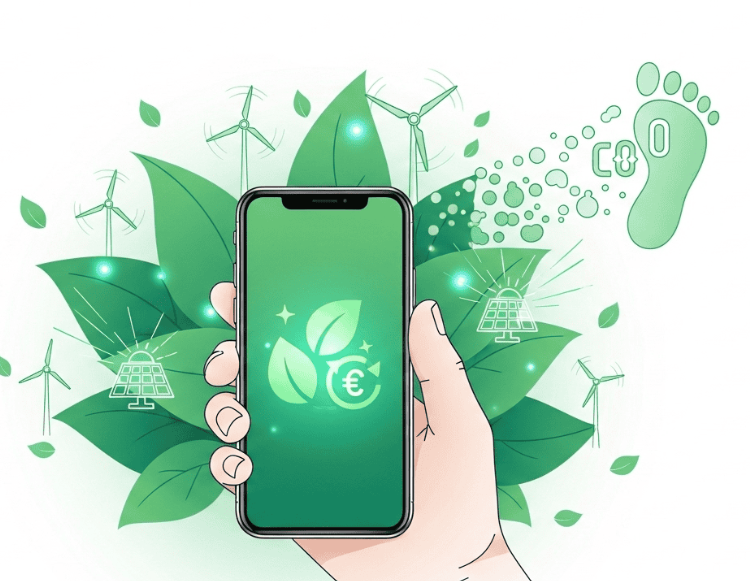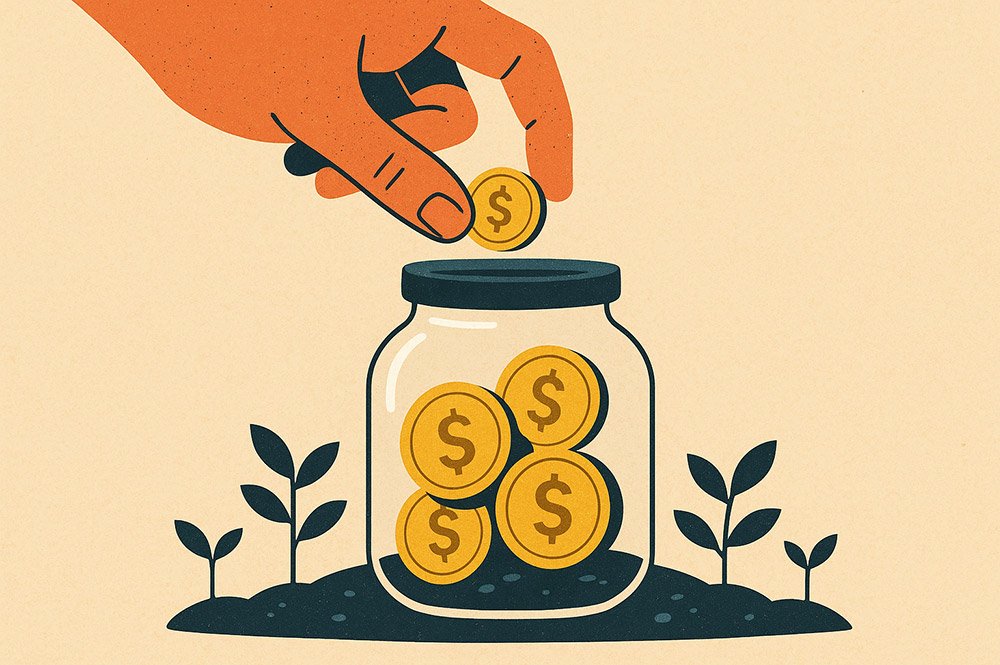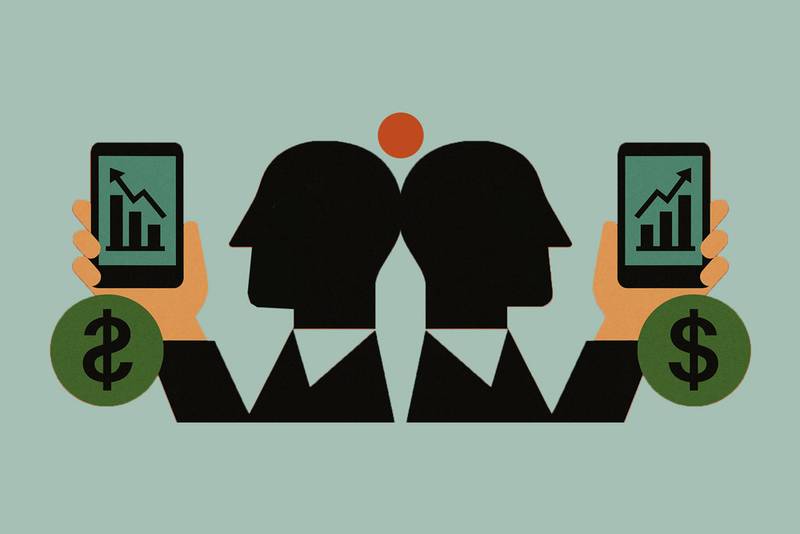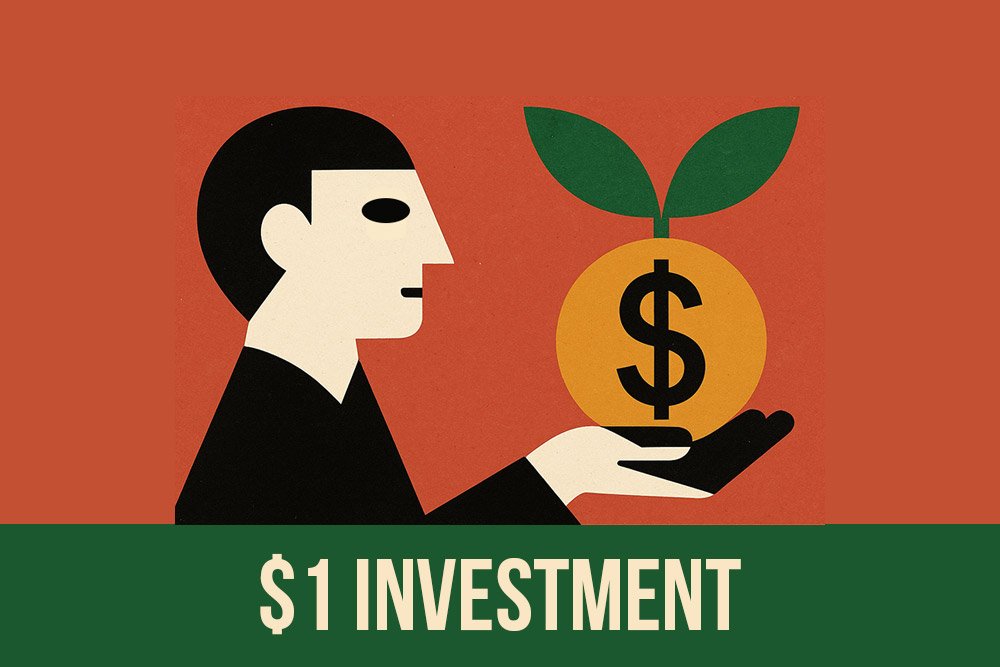Table of Contents
Why Micro-Investing
Imagine building a better life for yourself and your family, but every financial door seemed closed. No bank account. No credit history. No ability to save for emergencies or to let your capital grow. That’s the harsh reality for the nearly 1.4 billion unbanked adults worldwide who are stuck living outside the traditional financial system.
For decades, investing felt pretty much like a rich man’s game—a select few could afford a pricey financial advisor or could save up enough money to meet minimum deposit requirements at a bank. And the markets? They were just too complicated for the rest of the world to grasp.
But something remarkable is taking place. Micro-investing platforms are tearing down roadblocks, filling people with hope and potential who have been excluded from building wealth for too many decades. This transition has little to do with technology or comfort; rather, it is about economic fairness, people’s release, and millions of others first-ever opportunity to be part of the world’s economy.
Let’s delve into why micro-investing is not only a game-changer for the greater good but for one for how unbanked people can secure the future.
Who Becomes “Unbanked” and Why Is the Distinction Important?
The unbanked live without access to the fundamental financial services that most people have access to. Rather than checking or savings accounts, or any other formal ties to banks, they are effectively locked out.
Individuals have difficulty due to these reasons:
- Lack of proper identification documents
- Minimum balance requirements that they cannot afford
- Distrust of formal financial institutions
- Language barriers and literacy challenges
- Inability to qualify for accounts due to past negative experiences with banks
- High fees to open accounts, maintain required minimum balances, and keep taking money for small account balances
Individuals without bank accounts face constant obstacles. They pay high fees to cash checks, to send money through expensive wire services, and have no safe place to store their earnings. Most importantly, they are unable to build credit, access loans, or invest in their futures. This exclusion perpetuates cycles of poverty over generations.
Traditional Investment Has Been an Exclusive Club
Most of the time, it has been open to middle-class and wealthy clients creating barriers that kept regular working people on the sidelines. Twenty years ago, consider the typical requirements for opening a brokerage account:
- Hundreds or thousands of dollars as a minimum deposit
- $50 or more to pay for each trade
- A bank account to fund your trades
- A need to physically go to an office visit, or mail paperwork
- Enough financial literacy to understand complex investment products
It can be discouraging and impossible for the unbanked to participate. The unbanked investor can’t scrape $100 to invest; minimum deposits, trading, and maintenance fees would eliminate any gains. Generally, advisors were only interested in meeting with investors with substantial portfolios. Mutual funds required minimum investments of $1,000 to $3,000. Index funds were common, but they still demanded it. It makes no sense to require that because people do not have a bank account.
The result was a vicious cycle. Wealth begets wealth on compound interest, and appreciation on capital investments. You can never start accruing wealth if you cannot access investment vehicles. Ultimately, the line between the rich and others only got worse and returns on investments form a huge chunk of that disparity.
How Micro-Investing Changes Everything
Micro-investing is completely the opposite of that, though. The idea is very simple: Turn the model around and remove anything that obstructs regular folks from investing. No more minimum deposits; no more paperwork; no more need for a regular bank account in most cases. Just download an app, confirm your identity, and start investing whatever you have.
What Makes Micro-Investing So Innovative?
Fractional shares let people buy as much stock as they want. Want to buy a share of, say, a $500 stock? Just buy 1/100th of it for $5 instead. You were unable to do so when you were only buying full shares.
Automation does the whole thing; many apps use “round-up” that automatically invest your spare change. You pay $3.75 for a cup of coffee, and the app invests 0.25 cents of spare change after rounding out $4.00. A tiny sum can develop quite quickly.
They remove fees that would cripple little accounts. Just investing $10 is destroyed by a $5 trading fee. Micro-investing platforms realized that and created fee structures that function for minimal investors.
They teach in the app. While micro-investing platforms don’t make people explain the price-to-earnings ratios or market capitalization, they still explain in plain language to help people invest while learning.
Why the Unbanked Are the Perfect Audience for Micro-Investing
At first glance, it may seem strange to think of people without bank accounts as investors. However, micro-investing platforms are ideally suited to meet the needs of the unbanked for several compelling reasons.
Mobile-first matches unbanked’s existing practices. Many unbanked have cell phones even if they do not have a bank. In developing countries, cell phone penetration rates often exceed bank account rates. Micro-investment continues to drive the use of computers.
Small amounts are what the unbanked can afford. For someone living paycheck to paycheck, setting aside $5 is realistic while $500 is impossible. Micro-investing meets people where they are financially.
Real-World Impact: Numbers That Tell the Story
The transformation that micro-investing brings isn’t just theoretical. The following constitutes actual data from various platforms and regions that showcase the concrete impact on unbanked and underbanked populations.
Studies conducted in Kenya, India, and parts of Southeast Asia show that micro-investing options drive participation rates amongst unbanked individuals. In a pilot program in Ghana, more than 60% of participants that use a micro-investing app have never owned any investment product.
The compound effect over time is remarkable. Someone investing just $25 per month at a conservative 7% annual return would have accumulated $12,000 in 20 years. That may not sound much to wealthy investors, but for millions of people across the world who live on a few dollars a day, this constitutes transformational financial security—money for emergencies, school fees, or starting a small business.
More importantly, early research shows that people who started micro-investing engaged in better financial habits overall. They have become more cautious about spending, more interested in financial literacy, and more likely to seek other wealth-building opportunities. The very act of investing, even in tiny amounts, has caused a shift in mentality from survival to growth.
Technology: The Great Equalizer
None of this would be achievable if not for technological advancements in the last decade. Several crucial components all came together at the same time to make micro-investing viable for the unbanked.
Mobile internet became accessible worldwide. Even very remote places have 3G and 4G coverage bringing billions of people online. Smartphones became cheap enough so low-income individuals can get their hands on them, and most of them are internet-enabled. This is what provided a foundation for mobile-first financial services.
Blockchain and digital currencies made a path to the alternative to traditional banking infrastructure. While investing in cryptocurrencies is not for everyone and carries its risks, the tech underlying the coins allows for secure and low-cost transfers without the need for a bank account. Micro-investing platforms took advantage of these technologies and managed to cut fees and increase accessibility.
Artificial intelligence and machine learning power automatic investing, personal recommendation, and risk assessment without a necessity for expensive human financial advisors. The AI can analyze users’ spending habits and suggest investment amounts, and optimize portfolios. All these services would cost thousands of dollars if received from a human financial advisor, but now they are free.
Digital identity verification has seen a massive leap. Facial recognition, voice biometrics, and other means allow platforms to check users’ identification without constantly asking them to pull out documents. This is essential because most people without a bank account do not have a government-issued ID.
Cloud computing allows platforms to exist with almost zero overhead. They do not need physical infrastructure that costs a lot of money or a large staff. This keeps their fees low allowing them to service small accounts economically.
Breaking Down the Barriers: Accessibility Features
Modern micro-investing platforms employ some of the following features to overcome the obstacles that kept the unbanked out of traditional investing:
Flexible funding options: cash deposit locations, mobile money integration, and peer-to-peer transfers. Users don’t need bank accounts—they can fund their investment accounts via the channels they already use for daily transactions.
Simplified investment choices: instead of offering users thousands of random stocks, the platforms offer curated selections or diversified portfolios where they need just to make one choice. Investing becomes accessible to people with no financial education.
Social features and community support: users learn from peers who are facing the same challenges. Discussion forums, success stories, and group challenges build supportive environments where people feel comfortable asking basic questions without being judged.
The Psychology of Micro-Investing for First-Time Investors
However, micro-investing would not have become so successful without robust practicality and ingenious technology. Its biggest strength is how well it aligns with human psychology, which is especially important for beginners.
Small commitments feel safe. Investing $5 is safe and reversible. Investing $500 is scary and fixed. Small initial investments allow people not to think of putting it all in, and actual success builds natural confidence.
Gamification. Huge percentages of platforms include a game interface—achievements, progress bars, investment streaks, leaderboards. It’s an obvious psychological trick—most of the audience will play in-app games actively because they see real achievements, which means they work here, just people get rich instead of unlocking levels.
Visual progress. Watching a graph of your holdings increase, even by $5, provides empirical evidence the system is working. This is especially important for people who have never experienced asset growth.
Social proof. Users are more likely to believe these accounts seem like they’re from their communities: neighbors, friends, and acquaintances. This trust is important in the unbanked community.
Ownership. It enables people to experience ownership and immediate satisfaction desire for control. Most people who are unbanked operate in economies where they have little control over their economic prospects. The ability to own even a small part of a company gives the individual a sense of control and a role in the overall economy.

Challenges Micro-Investing for the Unbanked Currently Faces
Financial literacy gaps are still significant. While users can learn about investing on platforms, many people do not appreciate concepts like risk or diversification and have no idea about how volatile markets are. The simple platform displays may encourage them to make uninformed decisions and have unrealistic rates of return expectations.
Regulatory uncertainty remains a significant issue in many countries. Financial regulations had not been written for mobile-first micro-investing, and compliance with existing laws can be challenging while still carrying out the mission to serve unbanked persons.
Access to connectivity and technology remains an obstacle. Mobile phones are prevalent now, but not everyone has internet access or new phones capable of running complex apps.
Market volatility puts small investors at risk. If someone’s entire wealth is invested in $50, a market plunge of 20% will pack an emotional punch, even if the $10 loss is negligible. People may not want to keep participating.
Fraud and safety concerns. Fraudsters target micro-investing sites and their customers, so providing strong security in such simple interfaces is a significant investment for the companies.
Business model sustainability is questionable. Executing a business model wherein a firm serves people with small account balances without fees can be done in a difficult economic situation. Several micro-investing entities have exited the market or sold to other firms.
The Future: Integration and Innovation
Seamless integration: Micro-investing will integrate wherever it can. Do you think telecommunications firms will ever sell you the ability to get your micro-savings straight into micro-stocks every time you top your phone up? Or that retailers will provide shares of stock in a new public firm when you make a purchase? As more organizations step into the sector, expect it to be everywhere quickly. It genuinely does not matter if we believe it is a better idea for the economically deprived or not. Another critical point is that it will be where the financially excluded already are.
Aid from the government and NGOs: Developmental institutions increasingly view micro-investing as a method of reducing poverty and improving access to finances. An agency may pay the expenses or raise low-income funds for its staff, comparable to employer 401(k) matching for participant contributions.
Enhanced education: Learning aids contained in this category are simulations in virtual worlds, artificial intelligence trainers, and interactive tutorials. Platforms shall utilize educational tools in a future that does not exist to educate investors in more engaging methods modified to the appropriate instruction level.
Expanded asset categories: Micro-investments in assets other than equities and bonds will grow extensively. Diversified investing using micro-investments in small businesses, small entrepreneur credits, and greener investments in sustainable energy and other investment choices are also feasible.
Portable platforms: By utilizing universal protocols, one can move accounts between platforms. The platform automatically becomes one in which lock-in tactics are worthless because a micro-investing account became like a phone number.
AI optimization: Expert systems will handle money like personal money managers, learning from individual habits and goals to provide increasingly sophisticated guidance.
Success Stories: Real People, Real Impact
Maria, a domestic worker in the Philippines, funded her micro-investing app with $10. Setting up an automatic “round-up” option, the app invested her spare cents from daily purchases. Fast forward three years, and Maria realized that, without thinking about investing every day, she had over $800 in her account. Her daughter needed money for school supplies the next day. Instead of getting a high interest loan, Maria transferred just enough money from her investing account.
Rajesh, a street vendor in Mumbai who never had a bank account, deposited $2 per week from his pocket money into a mobile app that accepted cash loads from local shops. In two years, Rajesh’s portfolio was worth $250. Rajesh also gained enough confidence in using his investing app to open a bank account and apply for a small business loan to turn his cart into a small store.
Grace, a small farmer in Kenya, joined a community group and they combined their investments with other groups’ funds to invest money into agriculture companies. When the investment paid more return than expected, the group got enough dividend money to buy farming equipment proving a value for the entire village.
The similarities between these, and unmentioned individual stories are: a tiny start, time consistency, and a life-changing result. Not just financially, but mentally too. These people went from feeling that they are locked out of the economy to consistently growing participants.
How Does Micro-Investing Contribute to Financial Inclusion?
The official definition of financial inclusion is broader. As per the latest guidance issued by financial institutions, financial inclusion means that individuals and businesses have access to useful and affordable financial products and services that meet their needs—transactions, payments, savings, credit, and insurance—delivered in a responsible and sustainable way.
What is more, micro-investing platforms often become a gateway to the wider financial world. In other words, the person who started investing $5 can further create a mobile savings account. Then, the company becomes eligible for a small loan and buys microinsurance. Each step contributes to the person’s financial maturity and economic security.
At the same time, micro-investing correlates with the global agenda. The United Nations recognizes financial inclusion as the enabler of 7 out of 17 Sustainable Development Goals, including poverty reduction, gender equality, and economic growth.
Banks and other financial institutions also pay attention to the trend. Instead of competing with micro-investing companies, banks collaborate with them or launch their micro-products. Therefore, including the unbanked in the financial system is not just a charitable act but a profitable model.
The positive trend promotes development not only of separate investors but the whole micro-investing ecosystem. At the same time, a fortunate investment experience leads not only to financial security but the accumulation of personal wealth. In other words, the more unbanked people possess, the more they spend on commodities in local stores, into education, and setting up their companies. Eventually, they become wealthier, and communities become more prosperous.
What Do I Need to Start? Practical Advice for the Unbanked
For those unbanked who consider micro-investing, there are a few tips to make the first steps:
1. Find a Platform That Serves Your Region
Ideally, the site is created for one’s country or region and thus covers the regulations, currencies, and payment options from the same provider. Ask friends and relatives for recommendations to choose a trustworthy provider.
2. Start Small
Do not deny yourself the possibility to invest. It is always possible to begin with $1 or $5 and understand how the system works. Later, when one is familiar with it well, they can start contributing more.
3. Safety First
Understanding that financial fraud is possible in every area, make sure you work with a trustworthy provider. Check whether the platform uses two-factor authorization, whether they encrypt user data, and whether they insure accounts. This data appears on the provider’s website. On the other hand, never share your login credentials with anyone and be careful with those who promise to make you rich overnight.
4. Be Smart: Educate Yourself
Most reputable micro-investing platforms will provide free learning resources. Learn about the basics before making any decisions. Knowledge is the best defense against making the wrong ones. For more information on financial literacy and inclusion, visit the World Bank Financial Inclusion website.
5. Manage Your Expectations
There’s no such thing as getting rich quickly with micro-investing. Market returns historically average 7-10% per year for long periods, but returns vary. It’s best treated as a tool for gradually building wealth over the long run rather than a lottery ticket.
6. Build or Join a Community
Whether through user groups, forums, or local meetups, find a way to connect. The crowd’s collective insight is often more valuable than any single expert’s attitude.
The Bigger Picture: Economic Justice and Empowerment
Micro-investing for the unbanked ultimately reflects something larger than a financial invention. This is an issue of economic justice, human worth, and a more equal society.
For too long, the global financial system has done an excellent job of getting more benefits to those who already have it all. Investment returns increase wealth, but only for those who can invest. The outcome is that societies get more polarized, international confidence is destroyed, and people have become disoriented.
Micro-investing democratizes wealth-building, in other words. It says that the cashier in Manila is eligible to reap the prosperity of economic growth as much as the financier in Manhattan.
There is also a profound dignity about being an investor, not just a worker or a consumer. You change your identity and your way of defining yourself. You are not only making money and spending it. You are building it with something that is growing, that you are passing on to your kids if you like, and with something that you own in the future.

FAQ
What’s the Minimum That I Need to Start Micro-Investing?
Most micro-investing sites enable you to start with as little as $1 to $5 while some do not have a minimum and will enable you to start with what you may afford. The point is about starting, not the number.
Do I Need to Have a Bank Account So That I Can Use the Micro-Investing Apps?
Not always. While some of the platforms may require bank accounts, many are developed for the unbanked and will allow you to use alternative funding sources such as mobile money, deposits in cash at some partner stores, and transfers between peers. Check the basic requirements for the region you are in.
Is Micro-Investing a Safe Option?
Reputable micro-investing platforms will use bank-level security encryption and sometimes operate under financial authorities. Remember, investing has its risk given that your account value will rise and fall with the market. Pick the platforms that have been in existence longer and have solid reputations while avoiding the platforms that give guaranteed results.
How Much Would I Realistically Get While Doing Micro-Investing?
On average, the stock market experiences a 7-10% return annually in history, although it may be higher or lower in some years. If you have invested a sum of $25 monthly at 8% return, you shall have made a profit of around $15,000 after about 20 years. The reward shall depend on the total amount invested, the market performance, and the amount of time spent.
What If the Micro-Investing Firm Collapses?
Legitimate platforms keep your investments in separate custodial accounts. In this case, your stocks and bonds will outlive the company. If the enterprise is closed, your investments should be transferred to another custodian. Make sure that they have the proper custody arrangements.
Can I Lose All My Money with Micro-Investing?
While highly unlikely with diversified portfolios, it’s technically possible if all companies you’re invested in fail simultaneously. More realistically, you might experience temporary losses during market downturns. Diversification and long-term investing reduce these risks significantly.
How Is Micro-Investing Different from Saving Money?
Savings typically earn minimal interest, while investments historically return 7-10% annually on average. However, savings are stable and guaranteed, while investments fluctuate in value. Ideally, you’d have both emergency savings and long-term investments.
Do I Need to Pay Taxes on Micro-Investing Gains?
Tax rules vary by country, but generally yes; investment gains are taxable. However, some countries offer tax-advantaged accounts for small investors or exempt the first portion of investment income. Check your local tax laws or consult a tax professional familiar with your situation.
🌿 Curious about how your body stays healthy? Read more: Your Liver Health – 7 Healthy Liver Facts and Tips
Final Thoughts: A Future Within Reach
The story of micro-investing and the unbanked is still being written. We’re in the early chapters of what could be one of the most significant economic transformations in modern history—the moment when wealth-building became truly accessible to everyone, not just the privileged few.
The technology exists. The platforms are operational. The success stories are accumulating. What’s needed now is awareness, adoption, and continued innovation to reach the hundreds of millions still waiting for their opportunity.
If you’re someone who’s been locked out of traditional finance, micro-investing offers a key to open that door. It won’t solve every financial challenge or make you wealthy overnight. But it gives you something invaluable: a start. A foothold. A chance to participate in the economy not just as a worker or consumer, but as an investor building toward a better future.
And for those who are already inside the financial system, to support micro-investing for the unbanked isn’t just charitable—it’s enlightened self-interest. More stable economies benefit everyone. When poverty decreases, markets for business expand. More equal societies are also more safe and peaceful societies.
The future of micro-investing for the unbanked is not only promising, it’s transformative. It is a symbol of hope for billions of people who have been told, often implicitly but sometimes explicitly, that investing isn’t meant for them. Now, they can show that’s not the case, a dollar at a time.
The revolution has begun. The only thing in question is how rapidly it will spread and how many lives will be altered in the process. According to what we’ve witnessed so far, the answer in both cases is: dramatically more than most people think is possible.






